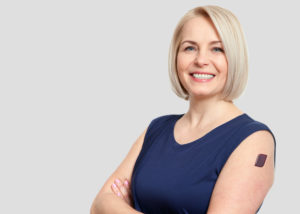A wearable smart patch will deliver precision data to help people personalise their diets and reduce their risk of developing lifestyle-related chronic diseases like Type 2 diabetes.
The world-first personalised nutrition wearable being developed by Melbourne-based start-up Nutromics painlessly measures key dietary biomarkers and sends the information to an app, enabling users to precisely track how their bodies respond to different foods.
The pioneering technology will be designed and manufactured in Australia.
A collaborative team led by Nutromics, Griffith University, RMIT and manufacturer Romar Engineering, with support from the Innovative Manufacturing Cooperative Research Centre (IMCRC), is now researching and developing the required manufacturing capabilities to pilot manufacture the device.
Pre-diabetes is estimated to affect more than 350 million people globally; in the US and China alone, 1 in 2 adults are pre-diabetic or diabetic.

A proof-of-concept Nutromics smart patch.
Nutromics co-CEO Peter Vranes said the smart patch leveraged emerging technologies to empower people to take greater control of their health.
“We’ve brought together a multi-disciplinary team of partners who are leaders in their fields to deliver Australian-made health technology that’s personalised and powerful,” Vranes said.
“Research has shown that what we eat affects us all differently; two people might have the same meal but their post-meal response can vary wildly.
“People want to make healthy food choices but with so much conflicting nutrition advice, many of us are confused about what that looks like.
“Being able to easily monitor key dietary biomarkers will give you the knowledge to personalise your diet to suit your own body, to get healthy and stay healthy.”
Diabetes is one of the largest chronic health challenges globally. Without taking any action, up to 70% of people with pre-diabetes can go on to develop Type 2 diabetes within the next four years, but with early interventions and lifestyle changes, the condition is largely preventable.
Integrated smart patch
The fabrication of sample collection will be led by Griffith University and Romar Engineering, with sensor integration and stretchable electronics fabrication undertaken at RMIT’s Micro Nano Research Facility.
Research Co-Director of RMIT’s Functional Materials and Microsystems Research Group, Professor Sharath Sriram, said the smart patch combined a complex sensing platform and stretchable electronics for improved conformity to skin.
Professor Sriram said RMIT researchers would integrate the technologies in a prototype smart patch that could be cost-efficiently manufactured via roll-to-roll (R2R) printing and was designed with the end-user at front of mind.
“This smart patch is a significant evolution in wearable health monitoring technology,” he said.
Additive manufacturing challenge

Professor Nam-Trung Nguyen
The IMCRC funding is enabling a $6.9 million total project investment (cash and in-kind) into addressing the challenge of additive manufacturing and large-scale production of the smart patches.
David Chuter, CEO and Managing Director at the IMCRC, said the project would build Australia’s capability in medical technologies manufacturing and improve the competitiveness, productivity and sustainability of the advanced manufacturing sector.
“The manufacturing challenges addressed by this project will not only help deliver a low-cost, high-tech smart patch, but will also create technologies that are transferable to other Australian companies in the consumer and medical tech space,” he said.
Professor Nam-Trung Nguyen, Director of the Queensland Micro- and Nanotechnology Centre at Griffith University, said the project was underpinned by the centre’s past and ongoing fundamental research in microfluidics and wearable, implantable microsystems.
“It is one of the research pillars at the Queensland Micro- and Nanotechnology Centre towards the commercialisation and translation of our discoveries for the benefit of end users,’’ he said.
“The project will benefit significantly from the recent addition of a femto second laser machining system funded by the ARC.”
Alan Lipman, CEO of Romar Engineering, an established manufacturer of medical devices, said collaboration was the way forward for Australian manufacturing.
“Working with entrepreneurs, academics and researchers to develop new medical technologies is essential to maintain Australia’s international competitiveness and to build a strong domestic manufacturing skills base.”
